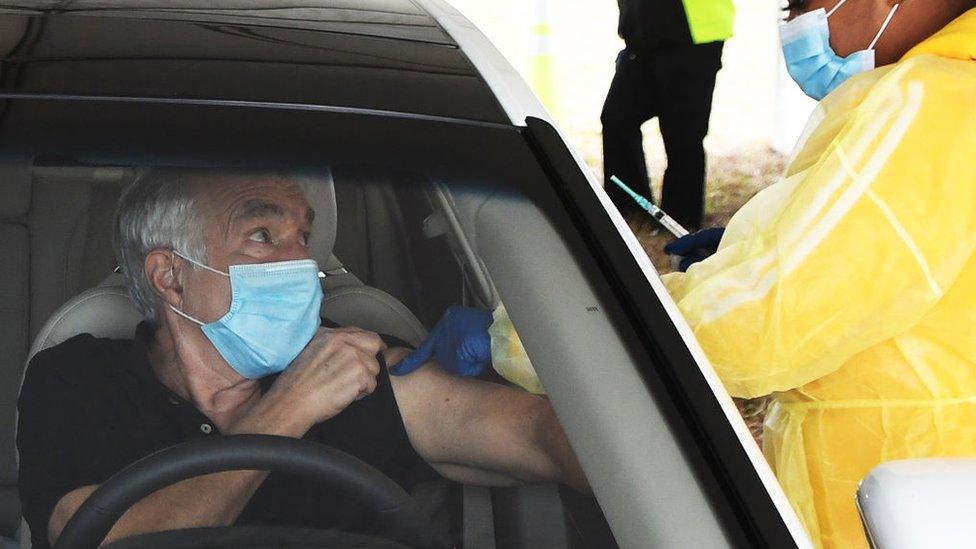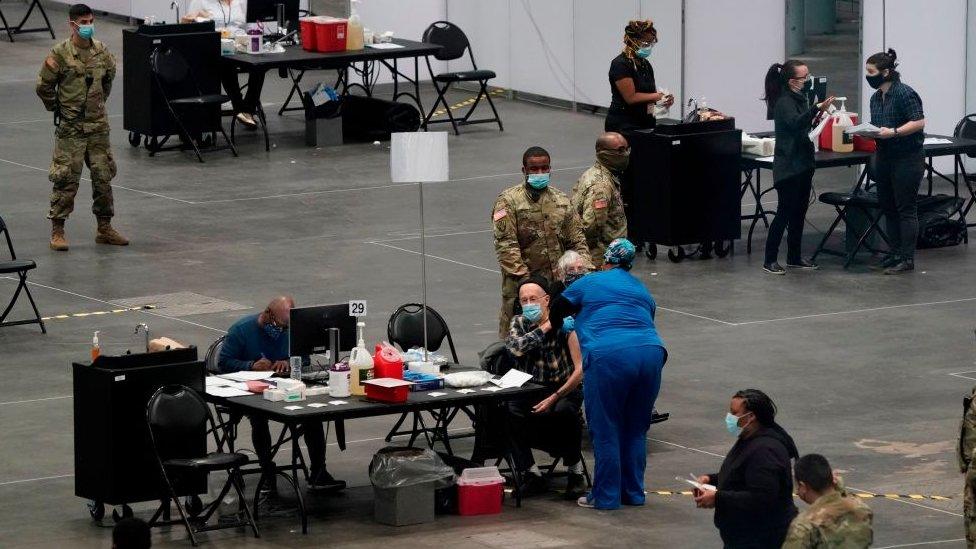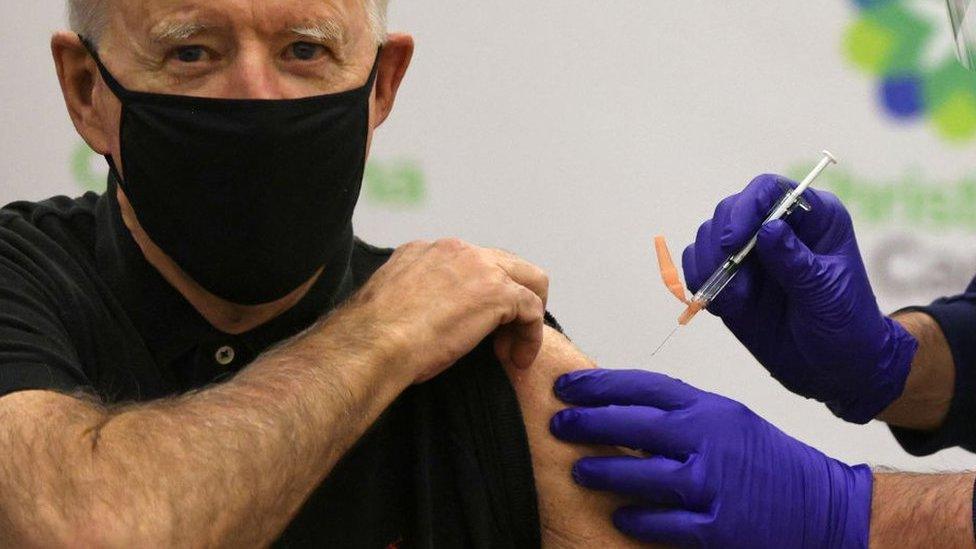Covid-19: Was US vaccine rollout a 'dismal failure' under Trump?
- Published

President Joe Biden has pledged to boost the rollout of Covid vaccines in the US, and has criticised the speed of the operation under the previous administration.
It's been "a dismal failure thus far," the president said after taking office.
He's committed to overseeing 100 million vaccine doses administered in his first 100 days, and has since said: "I think we may be able to get that to 1.5 million a day, rather than one million a day."
So how slow was the rollout under the Trump administration?
First target missed
As of 20 January, the day Mr Biden became president, about 16.5 million vaccines had been administered in the US, according to official statistics, external.
When you look at the countries doing the most vaccinations by population, the US is fourth after Israel, the UAE and the UK in terms of doses per 100 people.

However, the US fell far short of the target set by the Trump administration to vaccinate 20 million people by the end of 2020.
By 31 December, fewer than three million had received one.
Moncef Slaoui, who had been leading the government's vaccine rollout plan, said at the time: "We know that it should be better, and we're working hard to make it better."
Mr Slaoui has since submitted his resignation at the request of President Biden.
Vaccinations have sped up considerably since the start of the year, more than doubling in Mr Trump's last week in office compared to the first week of January.
The US did achieve more than one million doses a day on a few occasions during the Trump administration.
The daily average for the week before Mr Trump left office was less than 900,000, according to Our World in Data, external, although there could be a slight lag in recording daily vaccination figures.
That figure has since risen above one million doses, and President Biden has said he's hopeful of achieving 1.5 million doses a day, but "we have to meet that goal of a million a day".
An uneven rollout
There are wide variations across different US states - for example, as of 20 January, Alaska had given out more than 9,000 doses per 100,000 people and Alabama less than 3,000.

West Virginia has administered the second most vaccines per capita, with the state's governor calling it a "diamond in the rough".
It was the only state to opt out of a federal government programme through which large pharmacy chains vaccinated staff and residents in care homes (the first priority group) - and instead relied on local pharmacies, often with established links to care homes.
Mr Trump focused attention on what he saw as slow delivery by individual states, rather than issues at the federal level.
He tweeted on 29 December: "The Federal Government has distributed the vaccines to the states. Now it is up to the states to administer. Get moving!"
There have been issues around co-ordination and preparedness at state level, but local authorities have put this down to a lack of support from the federal government once the vaccines are distributed.
Why the slow start?
The US health system is complex, with a variety of services run by different providers within each state. These sometimes report to state or local officials but they can also operate independently.
This makes co-ordination challenging when trying to get supplies to local vaccination centres.
Dr Fauci, the president's top medical adviser, has said: "Whenever you take an undertaking of a magnitude of trying to vaccinate essentially most of the country, there's always going to be a bump in the road or a hiccup that we see."
There have also been distribution issues, such as in New York where officials have appealed for more supplies, external. Governors and mayors in other states have also complained of vaccine shortages.
President Biden's Chief of Staff, Ron Klain has said a plan to distribute vaccines "out into the community as a whole, did not really exist when we came into the White House".

A Covid-19 vaccination site in New York
Experts say significant logistical problems have arisen as well in administering the vaccines once they have been delivered to states.
As of 20 January, more than 35 million vaccines had been distributed across the US, but less than half of these had been put into people's arms.
Public health professor at George Washington University, Dr Leana Wen said: "The federal government seemed to have ceded its responsibility at the point the vaccines were given to the states.
"The state and local health departments have been asking for months for additional funding, and have not been given the funding that they need," she added.
Local authorities have said this delay affected the setting up vaccine centres, and hiring staff to work in them.
Some feel a more targeted approach is needed, with the government providing funding to local authorities, depending on their needs.
A long-delayed pandemic aid package was eventually agreed by Congress at the end of December. It provided $8.75 billion to states to assist with vaccination efforts.
What will Biden do differently?
The Biden administration has set out a Covid action plan, external, which includes measures to facilitate the distribution of vaccines.
The president wants to increase state funding, calling for a $25 billion package for vaccination manufacturing and distribution. This will have to be approved by US lawmakers.
He's planning to open 100 federally funded vaccination sites, as well as mobile units to reach people in remote areas, staffing them with thousands of workers.

Joe Biden received his second vaccine shot in January
More pharmacies will also be used as vaccination sites, further expanding the pool of health professionals delivering vaccines.
And in a significant departure from the previous administration, Biden's team has proposed releasing all available vaccine doses as soon as they become available.
This is a controversial approach, as it potentially delays the availability of the second booster jab, but it's one that has been adopted by the UK government, external and others.
This highlights problems that have already arisen over vaccine production shortages, and there are proposals to address this, external, such as securing commitments for increased supply from the manufacturers, and possibly reducing the vaccine dosage.
President Biden has appointed a new Covid-19 response team to plan and orchestrate these measures.
Five ways President Biden plans to tackle coronavirus in his first 100 days
